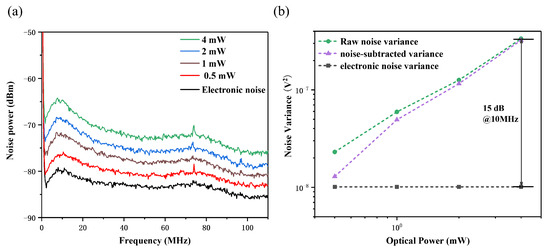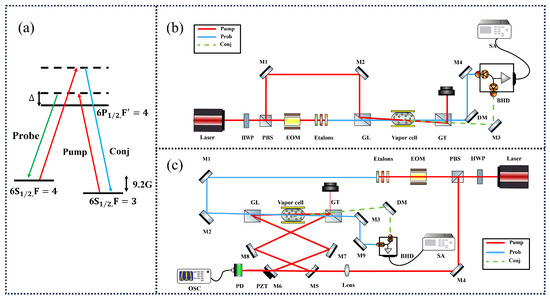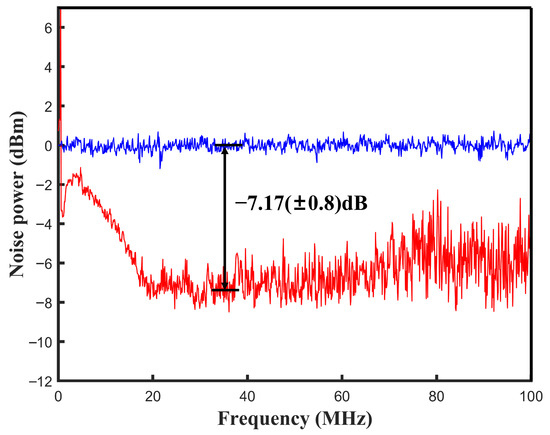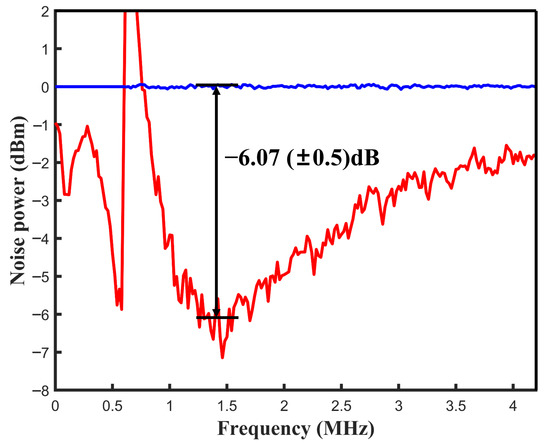Abstract
As an essential quantum resource, the intensity-difference squeezed state based on four-wave mixing (FWM) in atomic vapor is widely applied in quantum information processing. In particular, a high intensity-difference squeezing bandwidth is vital for the realization of high-speed information processing. However, limited by the bandwidth of photodetectors, broadband intensity-difference squeezed state based on this system has not yet been reported. Here, we developed a transimpedance broadband balanced homodyne detector at 895 nm, achieving a bandwidth greater than 100 MHz and a maximum signal-to-noise ratio of 15 dB with 4 mW optical power. Utilizing this detector in a nondegenerate FWM process based on cesium vapor, we experimentally achieved broadband intensity-difference squeezing with a bandwidth of 100 MHz, which yielded a maximum squeezing of −7.17 ± 0.8 dB between 20 and 40 MHz. Meanwhile, using this detector, we experimentally investigated the cavity-enhanced FWM process, achieving a squeezing level of −6.07 ± 0.5 dB within a 4 MHz frequency range, which is limited by the cavity bandwidth. This work provides a reliable detection tool and experimental foundation for the research and application of broadband squeezed light sources based on FWM.
1. Introduction
The intensity-difference squeezed state refers to the fluctuation of the intensity difference between signal and idler beams and is less than that of the corresponding shot noise level (SNL) [1,2]. As a crucial quantum resource [3], it has been widely used in quantum information processing, such as quantum random number generators [4,5], sub-shot-noise signal recovery and measurement [6,7], quantum-enhanced imaging [8], and magnetometry [9]. Due to the advantage of high gain and naturally matching the atomic transition wavelength, the direct interaction between optical fields and alkali-metal atoms is a viable approach for generating squeezed states, which has attracted considerable research interest in recent years [10,11,12]. In 1985, Slusher et al. [13] first observed a squeezed state through the four-wave mixing (FWM) process in sodium vapor. After this foundational work, several research groups successfully generated intensity-difference squeezed state in hot rubidium vapor, achieving a squeezing level of −9.2 dB [14,15,16]. Furthermore, a two-beam phase-sensitive amplification scheme based on FWM in rubidium vapor was employed, in which interference effects enhanced the squeezing level, the intensity-difference squeezing raise to −10.13 dB [17]. In addition, the intensity-difference squeezing level of −6.5 dB in hot cesium (Cs) vapor was also generated by stabilizing the frequency and phase difference between the pump and probe beams [18].
In quantum information processing with time-domain multiplexing, a broadband squeezed vacuum is essential to realize fast quantum processing [19,20]. The broadband squeezed has been widely applied in one-way quantum computing [21,22], high-speed quantum key distribution with nonclassical states [23,24], and gravitational-wave detectors [25]. By employing optical parametric amplification and coherent control schemes, a broadband vacuum squeezed state of −4 dB can be achieved within the bandwidth of 10–35 MHz at 1064 nm [26]. Additionally, an effective approach to achieving broadband squeezing is to shorten the cavity length of the OPA, through which broadband squeezing with bandwidths of 100 MHz and 30 MHz can be obtained [27,28]. Meanwhile, it has also been reported that using a monolithic periodically poled potassium titanyl phosphate (PPKTP) crystal with double-sided coating achieved broadband squeezing over a bandwidth of 10–1.2 GHz [29]. However, intensity-difference squeezed states generated via FWM in atomic ensembles with a bandwidth exceeding several tens of MHz have not yet been reported.
In the experiment presented here, we developed a broadband balanced homodyne detector (BHD), which consists of a transimpedance amplifier (TIA) and high-quantum-efficiency photodiodes. By optimizing the feedback capacitance and resistance, we achieved a bandwidth greater than 100 MHz and a maximum signal-to-noise ratio (SNR) of 15 dB at 10 MHz with 4 mW optical power. Using the BHD, we investigate the bandwidth intensity-difference squeezed state based on FWM process in atomic vapor with and without the optical cavity, respectively. Benefiting from the absence of cavity constraints, we recorded broadband squeezed vacuum states at 895 nm, ranging from 0 to 100 MHz by our home-built BHD. Furthermore, in the cavity-enhanced FWM configuration, compared to the non-cavity FWM process, the pump optical power is reduced from 600 mW to 336 mW, and the temperature of the vapor cell is reduced from 109 °C to 98 °C. However, the bandwidth of the intensity-difference squeezing reduced to 4 MHz due to the limitation of the cavity bandwidth.
2. The 100 MHz Broadband BHD at the 895 nm Wavelength
Homodyne detectors measure weak signals by interference with a local oscillator (LO) that is detected by two balanced photodiodes [30]. This configuration enables the effective detection of the shot-noise limit and the quantum fluctuations of optical quantum states, while totally eliminating classical noise, thereby making it one of the most effective techniques for measuring the squeezed state. In the detection of broadband squeezed states, the bandwidth, quantum efficiency (QE), and signal-to-noise ratio (SNR) of the BHD are the three key parameters to achieve highly squeezed levels. Therefore, designing a high-performance BHD at the 895 nm wavelength is crucial.
2.1. BHD Circuit Design
The circuit design of the balanced homodyne detector is shown in Figure 1, which mainly consists of a photoelectric conversion section and a weak optical signal amplification section. In this circuit, a pair of high-quantum-efficiency (QE) photodiode (First Sensor, QE exceeds 0.7 A/W at 895 nm) is selected with a junction capacitance () of 6 pF under a reverse bias voltage of 10 V. The subtraction signal, extracted at the series node (A) between the two photodiodes, is fed to the inverting input of the TIA, which performs low-noise amplification and simultaneous current-to-voltage conversion [31]. Owing to the virtual ground characteristic of the TIA inverting input, the weak photocurrent can only flow through the feedback resistor , producing a voltage drop (). At this point, the transimpedance gain can be expressed as

Figure 1.
Schematic diagram of the BHD circuit. The blue dashed box represents the photoelectric conversion section; the red dashed box represents the weak optical signal amplification section.
In addition to gain, we also focus on the bandwidth of the BHD, and the signal bandwidth () can be expressed as
in which is the gain bandwidth product,
, are the photodiode junction capacitances, is the TIA chip input capacitance, is the parasitic capacitances, and is the feedback capacitor, which is connected in parallel between the inverting input and the output of the TIA to suppress self-oscillation and stabilize the output while preserving the bandwidth. The equation of the is
Equation (2) shows that selecting an operational amplifier with a higher is essential for extending both the bandwidth and the transimpedance gain. In this circuit, we selected the OPA855 with a gain bandwidth product of 8 GHz as the TIA for weak optical signal amplification.
2.2. Performance Characterization of the Detector
We employed a diode laser at 895 nm as the LO to measure the performance characterization of the detector. We checked the linearity of the balanced homodyne detector by measuring the shot-noise levels versus LO powers, and the results are shown in Figure 2a. With the LO power double increased (from 0.5 mW to 4 mW), the output noise power of detector arose within the range of 0–100 MHz. The variance of the detector output as a function of input power on a bilogarithmic scale at analysis frequency of 10 MHz is shown in Figure 2b. Eventually, we achieve a maximum SNR of 15 dB at 10 MHz with a LO power of 4 mW. The results show that the photodetector can operate linearly and mitigate the influence of dark noise [32].

Figure 2.
The noise power spectrum is measured by spectrum analyzer, with RBW = 300 kHz, and VBW = 300 Hz. (a) The noise spectrum of BHD characterization from dc to 100 MHz with the increasing LO power. (b) The variance of output voltage as a function of LO power at 10 MHz. The dependence of noise variance on different LO power increases doubly at 10 MHz. The black square represents the noise variance of electronic noise, the green dot represents the noise variance of shot noise, and the purple square represents the noise variance after subtracting electronic noise from shot noise.
3. Broadband Intensity-Difference Squeezing at 895 nm Based on the FWM Proces
FWM represents a nonlinear interaction between light and matter that obeys both energy conservation and phase-matching conditions. The double- level structure of the FWM process is shown in Figure 3a; the Cs D1 line is used to form the double level structure with an excited level (, F’ = 4) and two ground levels (, F = 3 and F = 4). Two pump photons are absorbed, while the probe beam is amplified to an intensity of G, and a conjugate beam with an intensity of (G−1) is simultaneously generated, and the frequency difference between the conjugate and probe beams is 18.4 GHz. The double- scheme has a ground-state coherence that enhances the nonlinear effect and thereby increases both the FWM gain and the squeezing level. Based on this double- scheme, we investigate the nondegenerate FWM process with and without the optical cavity, respectively.

Figure 3.
Experimental layout for quantum-correlated twin beams and generating intensity-difference squeezing. (a) Double- scheme in the D1 line of Cs; is one-photon detuning; the two red arrows indicate the pump beam; the green arrow indicate the probe beam; the blue arrow indicate the conjugate beam. (b) Schematic diagram of the experimental setup for generating broadband intensity-difference squeezing via the FWM process in a Cs atomic ensemble. Laser: diode laser; HWP: half-wave plate; PBS: polarizing beam splitter; M1–M4: Mirro; DM: D-shaped mirror; EOM: electro-optic modulator; GL: Glan-laser polarizer; GT: Glan-Thompson polarizer; BHD: balanced homodyne detector; SA: spectrum analyzer; Pump: pump beam; Prob: probe beam; Conj: conjugate beam. (c) Schematic diagram of the experimental setup for generating cavity-enhanced intensity-difference squeezing via the FWM process. PZT: piezoelectric ceramics; M1–M9: Mirro; PD: high-gain detector; OSC: oscilloscope.
3.1. Experimental Generation of Intensity-Difference Squeezing with a 100 MHz Bandwidth
As shown in Figure 3b, in the experimental setup of the nondegenerate FWM process, the output beam from the laser first passes through HWP and PBS. The vertically polarized component selected by HWP and PBS is used as the pump beam. This pump beam is then reflected by two high-reflection mirrors (M1 and M2) and directed into the GL. The horizontally polarized component transmitted through PBS is sent to the EOM, which generates optical sidebands at ±9.2 GHz. This beam subsequently passes through three Etalons that filter out the carrier and the +9.2 GHz sideband, leaving the −9.2 GHz sideband to serve as the probe beam. At the center of the Cs vapor cell, the probe beam and the pump beam intersect at an angle of 6 mrad and generate the amplified probe and conjugate beams, which are finally filtered by a GT, separated by a DM, and directed onto the two photodiodes of the broadband BHD. Finally, the BHD is connected to a spectrum analyzer to measure the intensity-difference squeezing.
When the pump power up to 600 mW and the cell temperature stabilized at 109 °C, the intensity-difference squeezing was obtained from the experiment as shown in Figure 4. The blue curve denotes the SNL, which is measured by injecting two coherent beams with a total power equal to the sum of the probe and conjugate beam into the photodiodes of BHD. The red curve represents the intensity-difference squeezing generated via the nondegenerate FWM process. The level of squeezing is limited by optical losses and atomic decoherence, which is caused by spontaneous emission, absorption, and higher-order nonlinear effects. Due to the limitation of detector bandwidth, the results show that the 100 MHz broadband intensity-difference squeezing is obtained with an maximum squeezing level of −7.17(±0.8) dB from 20 MHz to 40 MHz. When the frequency exceeds 100 MHz, noise variance of intensity-difference becomes larger and squeezing level slightly decreased due to the bandwidth limitation of the BHD. The experimental results demonstrate that our home-made broadband BHD significantly extends the bandwidth for intensity-difference squeezing at 895 nm.

Figure 4.
Broadband intensity-difference squeezing noise spectrum generated via the FWM process in a Cs atomic ensemble, blue curve is shot-noise limit (SNL); red curve is the intensity difference between the probe and the conjugate beams. The spectrum analyzer settings are RBW = 300 kHz and VBW = 300 Hz.
3.2. Experimental Investigation of the Cavity-Enhanced FWM Process
To improve the utilization efficiency of the pump light in the FWM process, an effective approach is to combine an optical cavity into the FWM process. Only pump light resonates in the cavity, and the probe and conjugate beams pass through the cavity once, which allows the cavity-enhanced FWM process to still satisfy the optimal phase-matching condition. The cavity-enhanced FWM process enhanced light–matter interactions, which reduce the requirements of the pump power and vapor temperature. However, whether the presence of the cavity imposes a limitation on the squeezing bandwidth has not yet been experimentally verified. Therefore, using our home-made broadband BHD, we carried out an experimental investigation of squeezed states generated by integrating a six-mirror bow-tie cavity with a Cs vapor ensemble.
The experimental setup of the cavity-enhanced nondegenerate FWM process is shown in Figure 3c. Unlike Figure 3b, the pump light in FWM is prepared via a six-mirror bow-tie cavity. This cavity is formed by M5, M6, M7, M8, GL, and GT, in which the radius of curvature of M5 and M6 are both 100 mm. Also, the GL and GT provide an extinction ratio reaching :1. The reflectivity of mirrors M6, M7, and M8 each exceed 99%, and the transmission of mirror M5 is 23.5%. The M6 is mounted on a piezoelectric transducer (PZT) to adjust the cavity length, with a total cavity length of 1211.6 mm, resulting in an optimal pump beam waist of approximately 400 µm.
The laser beam is reflected by the PBS and then incident on M5 at a small angle of 8°. In the six-mirror bow-tie cavity, the resonant pump light crossed with the probe light at the center of the cesium atom multiple times at an angle of 6 mrad, realizing a cavity-enhanced FWM process. A high-gain photodetector monitors the weak transmission through M6 to observe the optical transmission peaks of the six-mirror bow-tie cavity. The amplified probe and the generated conjugate beams are subsequently measured with a home-built broadband BHD, whose output is analyzed using a spectrum analyzer.
As shown in Figure 5, the blue curve represents the SNL, while the red curve corresponds to the intensity-difference squeezing generated by the cavity-enhanced nondegenerate FWM process. The large peak shown at 0.7 MHz is classical noise from our laser. With a pump power of 336 mW and a Cs vapor temperature of 98 °C, we achieve the maximum intensity-difference squeezing level of −6.07 (±0.5) dB within the 4 MHz frequency range, due to the limited bandwidth of the cavity. Compared to FWM without cavity, the bandwidth of cavity-enhanced FWM reduce to 4 MHz. This is because pump power sharply decreases when exceeding the cavity bandwidth, which results in the squeezing level gradually decreasing. These results demonstrate that incorporating a six-mirror bow-tie cavity enhances light–matter interaction and reduces the required pump power and Cs vapor temperature in the FWM process. However, these benefits are confined to the cavity bandwidth, resulting in a narrower squeezing bandwidth.

Figure 5.
Intensity-difference squeezing noise spectrum generated by the cavity-enhanced nondegenerate FWM process in hot Cs vapor, blue curve is shot-noise limit (SNL); red curve is the cavity-enhanced intensity difference between the probe and the conjugate beams. The spectrum analyzer settings are RBW = 300 kHz and VBW = 300 Hz.
4. Conclusions
In summary, our work introduces a new broadband BHD with a bandwidth of approximately 100 MHz. The detector achieved a maximum SNR of 15 dB with a 4 mW LO. Between the DC-100 MHz frequency range, the shot-noise power scales approximately linearly with the LO power when it is doubled. This BHD was applied to the nondegenerate FWM process both with and without an optical cavity, respectively. We successfully observed broadband intensity-difference squeezing across a 100 MHz frequency range, with a maximum squeezing level of −7.17(±0.8) dB from 20 to 40 MHz at a pump power of 600 mW and a cesium cell temperature of 109 °C. Furthermore, we experimentally verified that, in the cavity-enhanced FWM process, the pump optical power required for the cavity-enhanced FWM process is reduced from 600 mW to 336 mW, and the temperature of the vapor cell is reduced from 109 °C to 98 °C. However, we obtained cavity-enhanced intensity-difference squeezing only within the 4MHz frequency band, reaching a maximum level of −6.07 (±0.5) dB. In a word, using our home-made BHD, we obtain intensity-difference squeezed state with a 100 MHz bandwidth and verify that the intensity-difference squeezing bandwidth generated by cavity-enhanced FWM is limited by the cavity bandwidth. Our results are expected to contribute to the advancement of FWM in atomic ensembles, providing an experimental foundation for the development of quantum information science and technology based on atomic vapor systems.
Author Contributions
Methodology, R.M.; validation, W.Z., X.W. and R.M.; writing—original draft preparation, R.M. and W.Z.; writing—review and editing, R.M., W.Z., X.W., X.Q. and X.S. All authors collaborated to the same extent in this research work and in the writing of the paper. All authors have read and agreed to the published version of the manuscript.
Funding
This research was funded by the National Natural Science Foundation of China (Grant No. U2441217), the Fundamental Research Program of Shanxi Province (Grant No. 202403021221019) and the Fund for Shanxi “1331 Project” Key Subjects Construction.
Data Availability Statement
The data related to the paper are available from the corresponding authors upon reasonable request.
Conflicts of Interest
The authors declare no conflicts of interest.
References
- Walls, D. Squeezed states of light. Nature 1983, 306, 141–146. [Google Scholar] [CrossRef]
- Huo, M.; Qin, J.; Sun, Y.; Yan, Z.; Jia, X. Generation of intensity difference squeezed state at a wavelength of 1.34 μm. Chin. Opt. Lett. 2018, 16, 052701. [Google Scholar] [CrossRef]
- Weedbrook, C.; Pirandola, S.; García-Patrón, R.; Cerf, N.J.; Ralph, T.C.; Shapiro, J.H.; Lloyd, S. Gaussian quantum information. Rev. Mod. Phys. 2012, 84, 621–669. [Google Scholar] [CrossRef]
- Lunghi, T.; Brask, J.B.; Lim, C.C.W.; Lavigne, Q.; Bowles, J.; Martin, A.; Zbinden, H.; Brunner, N. Self-testing quantum random number generator. Phys. Rev. Lett. 2015, 114, 150501. [Google Scholar] [CrossRef]
- Herrero-Collantes, M.; Garcia-Escartin, J.C. Quantum random number generators. Rev. Mod. Phys. 2017, 89, 015004. [Google Scholar] [CrossRef]
- Nabors, C.D.; Shelby, R.M. Two-color squeezing and sub-shot-noise signal recovery in doubly resonant optical parametric oscillators. Phys. Rev. A 1990, 42, 556–559. [Google Scholar] [CrossRef]
- Kennedy, T.A.B. Quantum theory of cross-phase-modulational instability: Twin-beam correlations in a χ(3) process. Phys. Rev. A 1991, 44, 2113–2123. [Google Scholar] [CrossRef] [PubMed]
- Casacio, C.A.; Madsen, L.S.; Terrasson, A.; Waleed, M.; Barnscheidt, K.; Hage, B.; Taylor, M.A.; Bowen, W.P. Quantum-enhanced nonlinear microscopy. Nature 2021, 594, 201–206. [Google Scholar] [CrossRef] [PubMed]
- Li, B.B.; Bilek, J.; Hoff, U.B.; Madsen, L.S.; Forstner, S.; Prakash, V.; Schäfermeier, C.; Gehring, T.; Bowen, W.P.; Andersen, U.L. Quantum enhanced optomechanical magnetometry. Optica 2018, 5, 850. [Google Scholar] [CrossRef]
- Appel, J.; Figueroa, E.; Korystov, D.; Lobino, M.; Lvovsky, A.I. Quantum memory for squeezed light. Phys. Rev. Lett. 2008, 100, 093602. [Google Scholar] [CrossRef]
- Polzik, E.S.; Carri, J.; Kimble, H.J. Spectroscopy with squeezed light. Phys. Rev. Lett. 1992, 68, 3020–3023. [Google Scholar] [CrossRef]
- Lvovsky, A.I. Squeezed Light. In Photonics: Scientific Foundations, Technology and Applications; John Wiley & Sons, Ltd.: Hoboken, NJ, USA, 2015; pp. 121–163. [Google Scholar]
- Slusher, R.E.; Hollberg, L.W.; Yurke, B.; Mertz, J.C.; Valley, J.F. Observation of squeezed states generated by four-wave mixing in an optical cavity. Phys. Rev. Lett. 1985, 55, 2409–2412. [Google Scholar] [CrossRef]
- Vahlbruch, H.; Mehmet, M.; Danzmann, K.; Schnabel, R. Detection of 15 dB squeezed states of light and their application for the absolute calibration of photoelectric quantum efficiency. Phys. Rev. Lett. 2016, 117, 110801. [Google Scholar] [CrossRef] [PubMed]
- Glorieux, Q.; Guidoni, L.; Guibal, S.; Likforman, J.-P.; Coudreau, T. Strong quantum correlations in four-wave mixing in 85Rb vapor. Quantum Opt. 2010, 7727, 772703. [Google Scholar]
- Boyer, V.; Marino, A.M.; Pooser, R.C.; Lett, P.D. Entangled images from four-wave mixing. Science 2008, 321, 544–547. [Google Scholar] [CrossRef] [PubMed]
- Liu, S.; Lou, Y.; Jing, J. Interference-induced quantum squeezing enhancement in a two-beam phase-sensitive amplifier. Phys. Rev. Lett. 2019, 123, 113602. [Google Scholar]
- Ma, R.; Liu, W.; Qin, Z.; Jia, X.; Gao, J. Generating quantum correlated twin beams by four-wave mixing in hot cesium vapor. Phys. Rev. A 2017, 96, 043843. [Google Scholar] [CrossRef]
- Yoshikawa, J.I.; Yokoyama, S.; Kaji, T.; Sornphiphatphong, C.; Shiozawa, Y.; Makino, K.; Furusawa, A. Generation of one-million-mode continuous-variable cluster state by unlimited time-domain multiplexing. APL Photonics 2016, 1, 060801. [Google Scholar] [CrossRef]
- Takanashi, N.; Inokuchi, W.; Serikawa, T.; Furusawa, A. Generation and measurement of a squeezed vacuum up to 100 MHz at 1550 nm with a semi-monolithic optical parametric oscillator designed towards direct coupling with waveguide modules. Opt. Express 2019, 27, 18900–18909. [Google Scholar] [CrossRef]
- Raussendorf, R.; Briegel, H.J. A one-way quantum computer. Phys. Rev. Lett. 2001, 86, 5188–5191. [Google Scholar] [CrossRef] [PubMed]
- Yokoyama, S.; Ukai, R.; Armstrong, S.C.; Yoshikawa, J.-I.; van Loock, P.; Furusawa, A. Demonstration of a fully tunable entangling gate for continuous-variable one-way quantum computation. Phys. Rev. A 2015, 92, 032304. [Google Scholar] [CrossRef]
- Lodewyck, J.; Bloch, M.; García-Patrón, R.; Fossier, S.; Karpov, E.; Diamanti, E.; Debuisschert, T.; Cerf, N.J.; Tualle-Brouri, R.; McLaughlin, S.W.; et al. Quantum key distribution over 25 km with an all-fiber continuous-variable system. Phys. Rev. A 2007, 76, 042305. [Google Scholar] [CrossRef]
- Mehmet, M.; Eberle, T.; Steinlechner, S.; Vahlbruch, H.; Schnabel, R. Demonstration of a quantum-enhanced fiber Sagnac interferometer. Opt. Lett. 2010, 35, 1665–1667. [Google Scholar] [CrossRef]
- Ganapathy, D.; Jia, W.; Nakano, M.; Xu, V.; Aritomi, N.; Cullen, T.; Kijbunchoo, N.; Dwyer, S.E.; Mullavey, A.; McCuller, L.; et al. Broadband quantum enhancement of the LIGO detectors with frequency-dependent squeezing. Phys. Rev. X 2023, 13, 041021. [Google Scholar] [CrossRef]
- Chelkowski, S.; Vahlbruch, H.; Danzmann, K.; Schnabel, R. Coherent control of broadband vacuum squeezing. Phys. Rev. A 2007, 75, 043814. [Google Scholar] [CrossRef]
- Serikawa, T.; Yoshikawa, J.-I.; Makino, K.; Frusawa, A. Creation and measurement of broadband squeezed vacuum from a ring optical parametric oscillator. Opt. Express 2016, 24, 28383–28391. [Google Scholar] [CrossRef]
- Breitenbach, G.; Müller, T.; Pereira, S.F.; Poizat, J.-P.; Schiller, S.; Mlynek, J. Squeezed vacuum from a monolithic optical parametric oscillator. J. Opt. Soc. Am. B 1995, 12, 2304–2309. [Google Scholar] [CrossRef]
- Ast, S.; Mehmet, M.; Schnabel, R. High-bandwidth squeezed light at 1550 nm from a compact monolithic PPKTP cavity. Opt. Express 2013, 21, 13572–13579. [Google Scholar] [CrossRef]
- Tasker, J.F.; Frazer, J.; Ferranti, G.; Allen, E.J.; Brunel, L.F.; Tanzilli, S.; D’Auria, V.; Matthews, J.C. Silicon photonics interfaced with integrated electronics for 9 GHz measurement of squeezed light. Nat. Photonics 2021, 15, 11–15. [Google Scholar] [CrossRef]
- Jin, X.; Su, J.; Zheng, Y.; Chen, C.; Wang, W.; Peng, K. Balanced homodyne detection with high common mode rejection ratio based on parameter compensation of two arbitrary photodiodes. Opt. Express 2015, 23, 23859–23866. [Google Scholar] [CrossRef]
- Wang, S.; Niu, X.; Wu, G.; Dong, R. 1.55 GHz balanced homodyne detector with high gain flatness based on low noise amplifier. Rev. Sci. Instrum. 2025, 96, 023003. [Google Scholar] [CrossRef] [PubMed]
Disclaimer/Publisher’s Note: The statements, opinions and data contained in all publications are solely those of the individual author(s) and contributor(s) and not of MDPI and/or the editor(s). MDPI and/or the editor(s) disclaim responsibility for any injury to people or property resulting from any ideas, methods, instructions or products referred to in the content. |
© 2025 by the authors. Licensee MDPI, Basel, Switzerland. This article is an open access article distributed under the terms and conditions of the Creative Commons Attribution (CC BY) license (https://creativecommons.org/licenses/by/4.0/).